ParakramaBahu I : 1153 - 1186
Eighth massa
The Eighth massa cooper coin of ParakraramaBahu the Great (1153 -
1186), the most outstanding monarch of the Polonnaruwa Period. A
golden epoch of Lankan history.
| SPECIFICATIONS |
| Denomination | Eighth massa |
| Alloy | Copper |
| Type | Struck |
| Diameter | 10. mm |
| Thickness | mm |
| Weight | 0.55 gms |
| Shape | Round |
| Edge | Plain |
| DieAxis | O° |
|
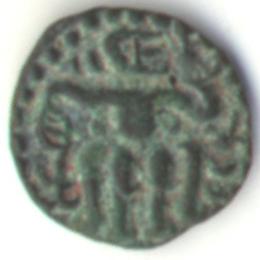
| 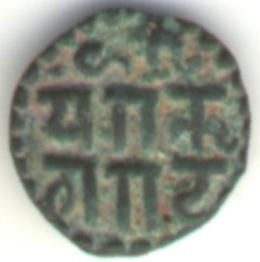
|
| Denomination | Eighth massa |
| Alloy | Copper |
| Type | Struck |
| Diameter | 10.4 mm |
| Thickness | 1.3 mm |
| Weight | 0.49 gms |
| Shape | Round |
| Edge | Plain |
| DieAxis | 180° |
|
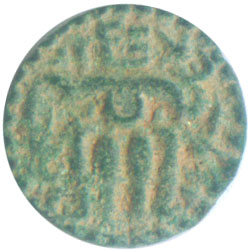
| 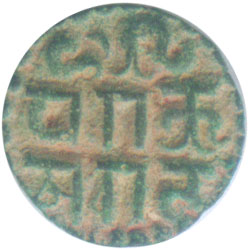
|
| 1/8 Massa | Mitchiner #832
|
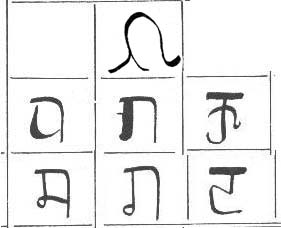 Obverse : Traditional Lankan massa design of
standing King with alter in front
Obverse : Traditional Lankan massa design of
standing King with alter in front
.
Reverse : Nagari legend Sri Pa ra kra ma Ba hu
The gold Kahavanu denomination is also known, but very rare. Most of
the full massa coins bearing the name ParakramaBahu were issued by
later king of this name. This is a rare coin unlike the six common
copper massa coins from the late Polonnaruwa and Dambadeniya era.
 ParakramaBahu's reign is
considered to mark the zenith of Lankan
greatness. The king enlarged and fortified Polonnaruwa, and adorned
the city with numerous palaces and pleasure gardens. The Jetavana
monastery, as well as the sculptures at GalVihara are monuments to his
religious generosity and aesthetic taste. Image on right is the famous
3.5 meter Rock-carved statue, of a Sage (believed to be ParakramaBahu)
reading a ola-leaf manuscript. The three Buddhist sects of monks were united
into one Nikaya Sanga, and he built the temple for the Tooth
Relic, in the neighborhood of the Royal Palace. He paid attention to
irrigation, built the great tank known as the `Sea of Parakrama' and
insisted that no water flow to the sea without being used for rice
cultivation. The period however saw many wars. In 1165, after Lankan
ambassadors had been insulted by King Ramanna of Burma, over an issue
involving restrictions on the international elephant trade,
ParakramaBahu sent a fleet from the coast north of Trincomalee to set
sail in the south-west monsoon and storm the city of Kusumiya on the
Pegu River. In 1169 he sent his general Lankapura to help the Pandyan
king, and became involved in a long costly campaign
against the Cholas in south India. Brilliant undoubtedly, the wars and heavy
taxation impoverished the island. He died in 1186 after ruling 33 years.
ParakramaBahu's reign is
considered to mark the zenith of Lankan
greatness. The king enlarged and fortified Polonnaruwa, and adorned
the city with numerous palaces and pleasure gardens. The Jetavana
monastery, as well as the sculptures at GalVihara are monuments to his
religious generosity and aesthetic taste. Image on right is the famous
3.5 meter Rock-carved statue, of a Sage (believed to be ParakramaBahu)
reading a ola-leaf manuscript. The three Buddhist sects of monks were united
into one Nikaya Sanga, and he built the temple for the Tooth
Relic, in the neighborhood of the Royal Palace. He paid attention to
irrigation, built the great tank known as the `Sea of Parakrama' and
insisted that no water flow to the sea without being used for rice
cultivation. The period however saw many wars. In 1165, after Lankan
ambassadors had been insulted by King Ramanna of Burma, over an issue
involving restrictions on the international elephant trade,
ParakramaBahu sent a fleet from the coast north of Trincomalee to set
sail in the south-west monsoon and storm the city of Kusumiya on the
Pegu River. In 1169 he sent his general Lankapura to help the Pandyan
king, and became involved in a long costly campaign
against the Cholas in south India. Brilliant undoubtedly, the wars and heavy
taxation impoverished the island. He died in 1186 after ruling 33 years.
Text edited from
* A Short History of Ceylon: H. W. Codrington,
London, MacMillan & Co. Ltd., 1929.
* Oriental Coins: Michael Mitchiner,
London, Hawkins Publications, 1978.
The coins were scanned at 600dpi and displayed at 600dpi.
Upper was purchased on ebay in March 2000 from a dealer in US.
Lower was purchased from a dealer in Colombo Fort in 2017 October.
The Standing man's body and the Nagari script on which is slightly different.




 Obverse : Traditional Lankan massa design of
standing King with alter in front
Obverse : Traditional Lankan massa design of
standing King with alter in front